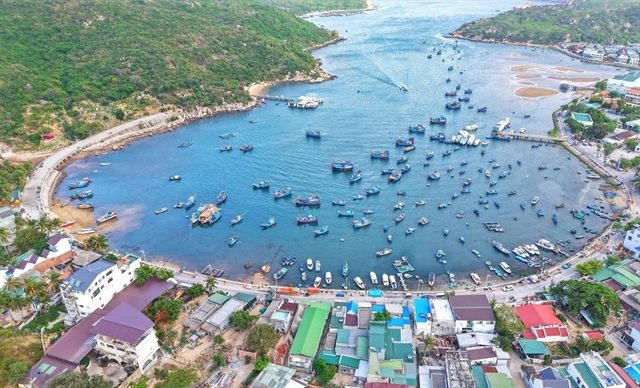 Life & Style
Life & Style

 |
| The merger brings together 385 km of Khánh Hòa’s coastline and 105 km from the former Ninh Thuận, creating a total of 490 km—the longest continuous coastline governed by a single province in Việt Nam. Photo thanhnien.vn |
KHÁNH HÒA — With the inclusion of Ninh Thuận, the newly restructured Khánh Hòa Province will not only boast the longest coastline in Việt Nam but also gain a significant boost in economic strength, cultural depth, and the potential for world-class coastal tourism.
Under a recent decision by the Prime Minister approving the reorganisation of administrative units and implementation of a two-tier local government model, Ninh Thuận and Khánh Hòa will be merged into a single province, which will continue to carry the name Khánh Hòa.
The merger results in a combined coastline of 490 km, 385 km from Khánh Hòa and 105 km from the former Ninh Thuận, making it the longest stretch of coastline under a single province in the country.
Both provinces are already home to key coastal routes that have delivered significant economic and tourism benefits. Notably, these routes can now be connected to form the longest uninterrupted coastal road in Việt Nam.
Most iconic bays
Nguyễn Tất Thành Boulevard, stretching over 35km, connects Nha Trang and Cam Ranh– two of Khánh Hòa’s most prominent tourist bays.
 |
| This Nguyễn Tất Thành coastal road is widely considered the most scenic in Khánh Hòa. Photo thanhnien.vn |
Beginning in downtown Nha Trang, the road winds through Cù Hin Pass and along Bãi Dài Beach, before reaching Cam Lâm District and linking to National Highway 1.
This coastal road is widely considered the most scenic in Khánh Hòa, with sweeping curves that hug seaside cliffs and offer panoramic ocean views.
Bãi Dài Beach, which lines part of this route, stretches nearly 13km in a graceful arc of white sand and clear blue water. Its peaceful atmosphere and distance from urban centres make it a favoured escape for both locals and tourists.
Lining this picturesque stretch are around 50 resort projects, ranging from luxury oceanfront resorts with infinity pools to secluded villas nestled in greenery – collectively creating an ideal destination for upscale coastal tourism.
The section from Cam Ranh Airport to Long Hồ Bridge in Cam Ranh City is currently being expanded to accommodate increased traffic and freight needs, supporting economic growth and tourism development in the area.
As a key arterial route, Nguyễn Tất Thành Boulevard significantly shortens travel time from Nha Trang to the airport (now approximately 35–45 minutes) and enhances accessibility to Bãi Dài and surrounding attractions, stimulating both regional development and property values.
A coastal route of natural beauty in Ninh Thuận
Known as Việt Nam’s leading renewable energy hub, with 57 solar and wind power projects totaling more than 3,700 MW, Ninh Thuận also boasts robust infrastructure, including deep-water ports and a coastal road from Cà Ná in Thuận Nam District to Vĩnh Hải in Ninh Hải District. This route connects inland areas with the sea, serving both economic and strategic purposes.
With its distinct dry climate, over 105km of coastline, and unique topography, Ninh Thuận is home to some of Việt Nam’s most captivating natural and cultural destinations, including Vĩnh Hy Bay, one of Việt Nam’s eight most beautiful bays; Núi Chúa National Park, a UNESCO-recognised biosphere reserve; Bàu Trúc Pottery Village, where the traditional Chăm pottery craft is listed by UNESCO as needing urgent safeguarding; Nam Cương Sand Dunes, ever-changing with the wind; and the country’s largest goat and sheep pastures.
The DT702 provincial road, also called the Vĩnh Hy – Bình Lập Coastal Route, connects Ninh Thuận and Khánh Hòa and offers a journey through Núi Chúa National Park, Hang Rái, Vĩnh Hy Bay, Bãi Kinh, and the region’s renowned vineyards.
The Vĩnh Hy – Bình Lập mountain pass, in particular, is a favourite among backpackers and road trip enthusiasts, offering rugged, dramatic landscapes paired with seaside charm. Travelers can enjoy the sweet flavour of ripe grapes from local vineyards while soaking in the salty ocean breeze –a signature Ninh Thuận experience.
 |
| Vĩnh Hy Bay is renowned for its unspoiled beauty, where majestic mountains embrace crystal-clear blue waters. The area also attracts visitors with its rich marine ecosystem and unique travel experiences. Photo thanhnien.vn |
A unified coastal tourism corridor
The merger of Khánh Hòa and Ninh Thuận sets the stage for a seamless coastal tourism corridor, blending the modern, developed beaches of Dốc Lết, Nha Trang, and Bãi Dài with the pristine, untouched landscapes of Vĩnh Hy, Bình Tiên, and Ninh Chữ.
This coastal continuity will allow visitors to enjoy a rich and diverse seaside journey, all within a single province.
Geographically longer and more diverse, the new Khánh Hòa Province also stands to grow in cultural richness, economic potential, and maritime vision.
Although it will remain one of the smallest provinces by area in central Việt Nam, it is now equipped with the internal strength and distinct identity to emerge as a key gateway to the sea. — VNS